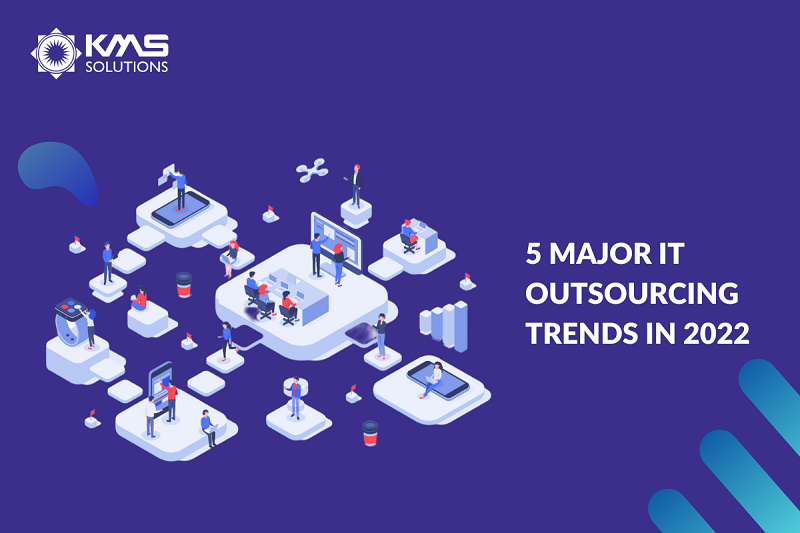Globally, IT outsourcing has become a staple for companies of all sizes. It’s easy to see why. Technology is now a vital part of every business’s operation – but as it advances and grows more sophisticated, it’s getting harder for one firm to manage everything on its own. Another driving force fueling the surge in IT outsourcing is the shortage of skilled IT personnel. With IT outsourcing, businesses get the chance to acquire experienced IT at a fraction of the cost of employing someone full-time.
According to Gartner, worldwide IT spending is anticipated to reach $4.5 trillion in 2022, a climb of 3% from 2021.
Here are the top 5 outsourcing trends in 2022 that you might want to consider for your upcoming digital projects.
1. On-demand cloud computing continues to gain popularity
As the amount of data that needs to be managed grows, so does the demand for cloud computing. More organizations are increasingly turning to the cloud to benefit from its processing power, flexibility, and scalability. Adopting cloud-based technology also allows corporations to save investment in traditional hardware for data storage and lower maintenance costs.
As of 2022, 60% of all corporate data is stored in the cloud, as per Statista. By 2026, public cloud investment will surpass 45% of all organization IT spending, up from less than 17% in 2021.
Since the world shifts towards cloud computing, companies across industries will increasingly search for IT service providers with experienced cloud engineers and developers familiar with cloud infrastructure and management to help them avoid cloud bill shock and ensure data security.
2. Greater emphasis on cybersecurity
With the increased usage of cloud computing and IoT, companies face the anxiety of data theft and security. The remote working mode makes it even harder to avoid compromised devices. Cybercrime has climbed up 600% since the start of the COVID-19 pandemic, resulting in an ever-growing need for cybersecurity protection. In fact, 64% of Deloitte respondents cited security capabilities as their primary concern driving their deployment of emerging technologies over the next three years.
As businesses look into cutting-edge, modular technologies to strengthen infrastructure reliability and prevent malware, this opens up new opportunities for Security-as-a-Service corporations. Instead of establishing ground-up firewall systems, many corporations are using Security-as-a-Service options. These security alternatives are often provided by a managed security service provider and are typically customized to the requirements of each company.
3. Blockchain services
Blockchain gained widespread notice when Bitcoin first utilized the technology as its underlying platform. Since then, many other corporations have begun executing comparable platforms to market their services and products.
As more organizations learn to integrate blockchain technology into their operations, experts believe this trend will intensify over the coming years. Global spending on blockchain solutions is projected to reach $11.7 billion by the end of the year.
Thus, there will be an enhanced demand for services related to developing decentralized applications (dApps) and software engineering for cryptocurrency projects or exchanges.
4. Artificial intelligence
With a market value of USD 1394.30 billion by 2029 at a CARP of 20.1%, AI is now one of the top outsourcing trends in the IT industry. Companies are starting to invest heavily in this technology to help them handle and mine enormous volumes of data to improve user experience. AI also gives businesses greater control over their data and processes, seamlessly integrating all aspects of their operations.
Rather than creating their AI tools and strategies (which might take years), many enterprises outsource this function to outside vendors with expertise in this field.
5. The growth of RPA
Robotic process automation (RPA) is a type of software technology that allows the development of software robots with more intelligent capabilities. In 2022, worldwide RPA software spending is forecasted to reach $2.9 billion, an increase of 19.5% from 2021.
Corporations invest heavily in RPA to expedite business process automation initiatives and digital transformation projects, connecting their legacy nightmares to digital dreams to enhance operational efficiency.
Besides leveraging RPA to execute repetitive work like filling out forms and processing paperwork, some companies have started integrating RPA technology with AI to drive innovation further. For instance, RPA is installed to process order forms and deliveries while AI is added to offer production suggestions for clients.
In 2022, RPA tackles platforms that necessitate more advanced AI and richer user interfaces, enabling businesses to incorporate RPA into their current processes better and use it to manage their existing technologies.
Final Words
2022 is a fascinating year filled with new possibilities for both businesses and outsourcing providers. More and more corporations will seek outsourced digital teams to assist them with cybersecurity, blockchain development, cloud computing, RPA, and AI.
Regarding IT outsourcing services providers, they will need to prepare for a rise in the demand for engineers with experience in these emerging technologies. Otherwise, they risk losing out on new business opportunities to competitors who can deliver more flexible solutions.
Feel free to reach out to us if you’re seeking a qualified outsourcing partner who can help you with any of the aforementioned services. With years of experience in the industry, the KMS software development team has successfully delivered numerous digital projects to businesses across industries. We would be happy to respond to all your inquiries.
Want to discuss your outsourcing software project? Let our team help!








